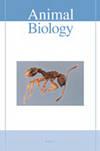雌雄同体蝎(蝎科)单性生殖凋落物的适合度差异
IF 0.9
4区 生物学
Q2 ZOOLOGY
引用次数: 0
摘要
相似环境中的克隆谱系可能受到非孟德尔遗传的影响,如母亲年龄效应和发育不稳定性。这些机制可能影响孤雌生殖幼崽的发育适合度。本研究以蝎子Tityus stimurus (Thorell, 1876)为研究对象,分析了非孟德尔变异对孤雌生殖凋落物的影响。在相同的控制条件下饲养5只母鼠75只幼鼠,并通过幼鼠的后代适合度特征(产仔数、原体大小、发育时间和死亡率)的差异来观察和评价它们的发育情况。第一胎和第二胎的产仔数相似,但第二胎在早期阶段(第二胎和第三胎)的发育时间比第一胎长。这些结果表明,在后续的产仔过程中,母斑头蝽分配营养资源的目的是最大化产仔数,而不是最大化发育适应性。在早期而不是晚期发现的发育时间的差异可能是由于年轻个体的随机发育变异而发生的。这种发育时间上的差异有可能影响幼鱼在自然环境中的生存,因为与那些长得快的个体相比,长得快的个体可能会避开大型捕食者,并吃掉更大的猎物。本文章由计算机程序翻译,如有差异,请以英文原文为准。
Fitness differences between parthenogenetic litters of the synanthropic scorpion Tityus stigmurus (Scorpiones: Buthidae)
Clonal lineages in similar environments may be influenced by non-Mendelian inheritance, such as maternal age effects and developmental instabilities. These mechanisms may affect the developmental fitness of parthenogenetic litters. In this study, the scorpion Tityus stigmurus (Thorell, 1876) was used to analyze the effects of non-Mendelian variation on parthenogenetic litters. A total of 75 juveniles from five females were reared under the same controlled conditions, while their development was observed and evaluated through differences in offspring fitness traits (litter size, prosoma size, developmental time, and mortality) between the litters. First and second litters had a similar litter size, although second litters exhibited longer developmental time in the early instar stages (second and third) than first litters. These results indicate that T. stigmurus females allocated nutrient resources to maximize litter size rather than developmental fitness in subsequent litters. Differences in developmental time found in early instars but not in late instars may have occurred as a result of stochastic developmental variations in young individuals. Such variation in duration of development has the potential to influence survival of juveniles in natural environments because individuals that grow faster may avoid large predators and consume larger prey, compared to those that do not.
求助全文
通过发布文献求助,成功后即可免费获取论文全文。
去求助
来源期刊

Animal Biology
生物-动物学
CiteScore
2.10
自引率
0.00%
发文量
34
审稿时长
3 months
期刊介绍:
Animal Biology publishes high quality papers and focuses on integration of the various disciplines within the broad field of zoology. These disciplines include behaviour, developmental biology, ecology, endocrinology, evolutionary biology, genomics, morphology, neurobiology, physiology, systematics and theoretical biology. Purely descriptive papers will not be considered for publication.
Animal Biology is the official journal of the Royal Dutch Zoological Society since its foundation in 1872. The journal was initially called Archives Néerlandaises de Zoologie, which was changed in 1952 to Netherlands Journal of Zoology, the current name was established in 2003.
 求助内容:
求助内容: 应助结果提醒方式:
应助结果提醒方式:


